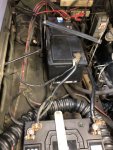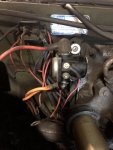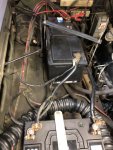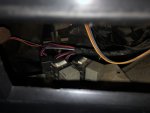.Max.Power.
New member
- 14
- 4
- 3
- Location
- Germany
Hey folks,
being a new 1985 Chevy M1008 owner since Sunday, I got some initial questions.
I am not a mechanic but willing to learn. I also got the TMs but haven'T got through them, yet.
I've structured my post a bit so that you can respond easier.
Topic 1 - voltage/battery
battery setup
Looking at picture 1 I assume that the car has been converted to 12V as the battery setup is a parallel circuit.
The negative pole of the front bat. (left) is connected to the minu pole of the rear bat. (down) and grounded via the chassis.
Also are the positive poles connected to each other and lead further towards the 'positive terminal junction box'
Following this web page (http://www.chaosboyz.nl/rubriek/techniek/techombouw12v.htm) my configuration looks like their option3 (Convert to two 12-volt isolated systems. One system utilizing the two existing batteries and one alternator. The second system utilizing the other alternator and an additional battery), as I still got both alternators.
Am I right or is the electric completely messed up from what you can see? Can I keep on driving like this?
Engine startup
Most of the time the car starts easily. Sometimes it does not start after the lights went off, somehow if there is not enough power/low bat. but then I just tried 2 or 3 times more and it started without issues.
What could be the reason for this hickup?
Background: The car was not moved a lot the last years but the front bat. is new and I also took it for a 200 mile ride last weekend.
voltage indicator
On pic 2 you can see a voltage indicator. I was already told that this is not an original from the M1008 CUCV but its there - but it does not work. Actually I don't care but I would feel better if it would.
Ideas how to fix or how to connect possible cables?
cigarette lighter
Also not an original feature of the vehicle but useful. At the moment the plus cable is linked to the plus pole of the rear battery. I therefore assume (given it is a 12V setup - as mentioned earlier) that I can pluf in my phone carger or sat nav.
Am I right or will the plugged in device just explode?
Topic 2 - glow plugs
My CUCV has an automatic glow plug system and it seems to work.
Should I leave it like this or change to a manuell one?
Topic 3 - loose cable
Picture 3 shows a loose orange cable near the glow plug relais.
Where does that belong to?
As mentioned I am not keen on restoring the original state of the car. For my purposes it should just work fine and smoothly.
Hope I can get some info here.
Max


 [/U][/U]
[/U][/U]
being a new 1985 Chevy M1008 owner since Sunday, I got some initial questions.
I am not a mechanic but willing to learn. I also got the TMs but haven'T got through them, yet.
I've structured my post a bit so that you can respond easier.
Topic 1 - voltage/battery
battery setup
Looking at picture 1 I assume that the car has been converted to 12V as the battery setup is a parallel circuit.
The negative pole of the front bat. (left) is connected to the minu pole of the rear bat. (down) and grounded via the chassis.
Also are the positive poles connected to each other and lead further towards the 'positive terminal junction box'
Following this web page (http://www.chaosboyz.nl/rubriek/techniek/techombouw12v.htm) my configuration looks like their option3 (Convert to two 12-volt isolated systems. One system utilizing the two existing batteries and one alternator. The second system utilizing the other alternator and an additional battery), as I still got both alternators.
Am I right or is the electric completely messed up from what you can see? Can I keep on driving like this?
Engine startup
Most of the time the car starts easily. Sometimes it does not start after the lights went off, somehow if there is not enough power/low bat. but then I just tried 2 or 3 times more and it started without issues.
What could be the reason for this hickup?
Background: The car was not moved a lot the last years but the front bat. is new and I also took it for a 200 mile ride last weekend.
voltage indicator
On pic 2 you can see a voltage indicator. I was already told that this is not an original from the M1008 CUCV but its there - but it does not work. Actually I don't care but I would feel better if it would.
Ideas how to fix or how to connect possible cables?
cigarette lighter
Also not an original feature of the vehicle but useful. At the moment the plus cable is linked to the plus pole of the rear battery. I therefore assume (given it is a 12V setup - as mentioned earlier) that I can pluf in my phone carger or sat nav.
Am I right or will the plugged in device just explode?
Topic 2 - glow plugs
My CUCV has an automatic glow plug system and it seems to work.
Should I leave it like this or change to a manuell one?
Topic 3 - loose cable
Picture 3 shows a loose orange cable near the glow plug relais.
Where does that belong to?
As mentioned I am not keen on restoring the original state of the car. For my purposes it should just work fine and smoothly.
Hope I can get some info here.
Max


 [/U][/U]
[/U][/U]Attachments
-
93.3 KB Views: 10
-
112.5 KB Views: 9






